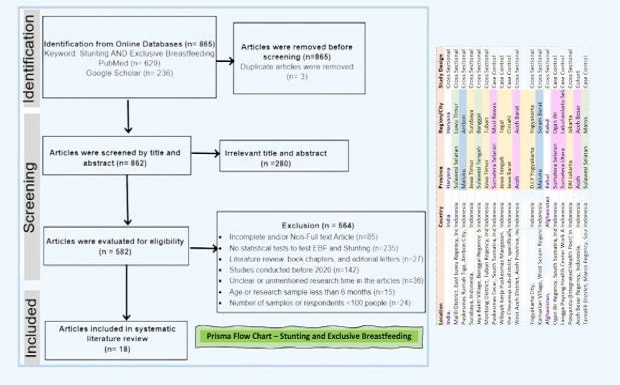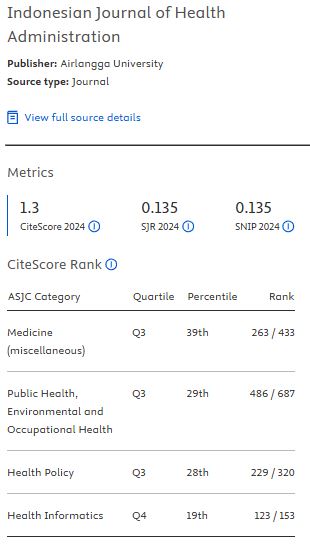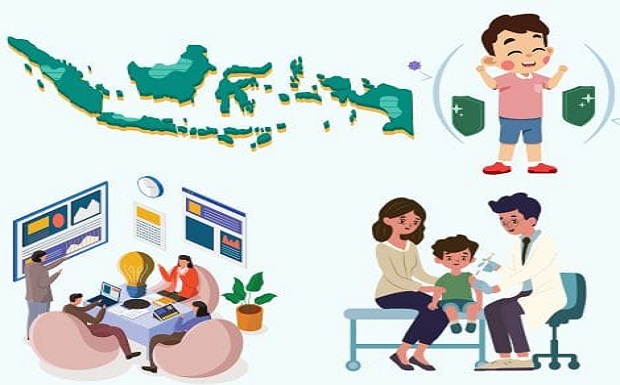SYSTEMATIC LITERATURE REVIEW: EXCLUSIVE BREASTFEEDING AND STUNTING – A PREVENTIVE APPROACH FOR HEALTH POLICY

Downloads
Background: Stunting negatively impacts children’s growth, cognitive development, and future productivity. A frequently overlooked yet critical risk factor is the absence of exclusive breastfeeding (EBF). Many studies continue to explore and update the critical role and the urgency of EBF.
Aims: This research aimed to identify and analyze the previous studies on the relationship between EBF and stunting to capture a comprehensive understanding of EBF’s role in stunting prevention and various associated factors.
Methods: A Systematic Literature Review with the PRISMA (Preferred Reporting Items for Systematic Reviews and Meta-Analysis) protocol was employed through four steps – identification, screening, inclusion, and eligibility. A total of 865 articles were initially retrieved from electronic databases (Google Scholar and PubMed). Following the inclusion and exclusion criteria, 18 studies resulted in the final review.
Results: There was a significant relationship between EBF and stunting incidents. Key contributing barriers are predominantly observed in families with low socioeconomic status and limited educational attainment. In addition, prevailing public perceptions and traditional cultural practices—such as pre-lacteal feeding and CF-were also identified as influential factors.
Conclusion: The failure to practice EBF contributes to increased stunting, primarily due to the absence of optimal nutrition and immune protection provided by breast milk. The ignorance of EBF stems from customs and culture that have been applied from era to era. Addressing this issue requires multidimensional interventions, particularly focusing on educational and environmental support. Future research should adopt a multi-sectoral approach to inform evidence-based policy-making for more effective stunting prevention.
Keywords: Children aged under 5 years, chronic nutrition, exclusive breastfeeding, stunting, systematic literature review.
Afghanistan National Nutrition Smart Survey Report (2022) Afghanistan National Nutrition Smart Survey Report. Afghanistan: Afghanistan Nutrition Cluster.
Agussalim et al. (2024) ‘Risk Factor Analysis of Stunting in Children Aged 6-23 Months in Tanralili District, Maros Regency, Indonesia’, National Journal of Community Medicine, 15(07), pp. 559–565. Available at: https://doi.org/10.55489/njcm.150720244014.
Amalo, H.W. and Davidz, I. (2023) ‘Factors Associated with the Incidence of Stunting in Toddlers Aged 24 - 59 Months in the Working Area of the Oebobo Health Center, Kupang City’, Jurnal Penelitian Pendidikan IPA, 9(8), pp. 6682–6687. Available at: https://doi.org/10.29303/jppipa.v9i8.4118.
Andika, F. et al. (2020) ‘Analysis of Stunting Incidence Factors in Toddlers Aged 23-59 Months in the Work Area of the Padang Tiji Community Health Center, Pidie Regency, 2020’.
Appelbaum, M. et al. (2018) ‘Journal article reporting standards for quantitative research in psychology: The APA Publications and Communications Board task force report.’, American Psychologist, 73(1), pp. 3–25. Available at: https://doi.org/10.1037/amp0000191.
Asmin, E. and Abdullah, M.R. (2021) ‘ASI Eksklusif dan Imunisasi Berhubungan dengan Kejadian Stunting pada Anak Usia 9-24 Bulan di Puskesmas Rumah Tiga, Ambon’, Poltekita : Jurnal Ilmu Kesehatan, 15(2), pp. 196–201. Available at: https://doi.org/10.33860/jik.v15i2.487.
Asprika, M.C.W. (2023) ‘Hubungan Pemberian ASI Eksklusif dan Sikap Ibu dengan Kejadian Stunting Pada Balita Usia 24-59 Bulan di Wilayah Kerja Puskesmas Cecar’, 3(1).
Azizah, A.M., Dewi, Y.L.R. and Murti, B. (2022) ‘Meta-Analysis: Breastfeeding and Its Correlation with Stunting’, Journal of Maternal and Child Health, 7(3), pp. 334–345. Available at: https://doi.org/10.26911/thejmch.2022.07.03.10.
Bustami, B. and Ampera, M. (2020) ‘The Identification of Modeling Causes of Stunting Children Aged 2–5 Years in Aceh Province, Indonesia (Data Analysis of Nutritional Status Monitoring 2015)’, Open Access Macedonian Journal of Medical Sciences, 8(E), pp. 657–663. Available at: https://doi.org/10.3889/oamjms.2020.4659.
Chawla, S. et al. (2020) ‘Undernutrition and associated factors among children 1-5 years of age in rural area of Haryana, India: A community based cross-sectional study’, Journal of Family Medicine and Primary Care, 9(8), p. 4240. Available at: https://doi.org/10.4103/jfmpc.jfmpc_766_20.
Dabar, D. et al. (2020) ‘Risk factors for undernutrition in under-five children living in a migrant populated area of South Delhi’, Journal of Family Medicine and Primary Care, 9(4), p. 2022. Available at: https://doi.org/10.4103/jfmpc.jfmpc_1185_19.
Dendy, E.R.A. et al. (2024) ‘The Association Between Exclusive Breastfeeding and the Occurrence of Stunting Among Children Aged 12-60 Months in Community Health Centers in Yogyakarta City’, Jurnal Kedokteran Diponegoro (Diponegoro Medical Journal), 13(1), pp. 37–43. Available at: https://doi.org/10.14710/dmj.v13i1.40723.
Dewi Agustin et al. (2024) ‘Analysis of Relationship of Breastfeeding Behaviour in Working Mothers and The Incident of Stunting’, Journal of Educational Innovation and Public Health, 2(3), pp. 207–215. Available at: https://doi.org/10.55606/innovation.v2i3.3113.
Dolang, M.W., Pelamonia, A. and Simanjuntak, Y.F. (2024) ‘Determinants of Toddlers’ History with Stunting Incidence in the Coastal Community’, Window of Health : Jurnal Kesehatan, pp. 194–202. Available at: https://doi.org/10.33096/woh.vi.788.
Edmond, K.M. et al. (2018) ‘Can community health worker home visiting improve care-seeking and maternal and newborn care practices in fragile states such as Afghanistan? A population-based intervention study’, BMC Medicine, 16(1), p. 106. Available at: https://doi.org/10.1186/s12916-018-1092-9.
Fatihunnajah, M.F. and Budiono, I. (2023) ‘Faktor Determinan Kejadian Stunting pada Balita Usia 24-59 Bulan’, Indonesian Journal of Public Health and Nutrition, 3(1), pp. 69–79. Available at: https://doi.org/10.15294/ijphn.v3i1.57748.
Gaidhane, A. et al. (2021) ‘Determinants of Stunting and Wasting Among the Children Under Five Years of Age in Rural India’, International Journal of Current Research and Review, 13(11), pp. 18–26. Available at: https://doi.org/10.31782/IJCRR.2021.131108.
Gebrekidan, K. et al. (2021) ‘Exclusive breastfeeding continuation and associated factors among employed women in North Ethiopia: A cross-sectional study’, PLOS ONE. Edited by F.T. Spradley, 16(7), p. e0252445. Available at: https://doi.org/10.1371/journal.pone.0252445.
Husna, A. and Farisni, T.N. (2022) ‘Hubungan ASI Eksklusif dengan Stunting Pada Anak Balita di Desa Arongan Kecamatan Kuala Pesisir Kabupaten Nagan Raya’, Jurnal Biology Education, 10(1), pp. 33–43. Available at: https://doi.org/10.32672/jbe.v10i1.4122.
International Institute for Population Science (2022) National Family Health Survey (NFHS), 2019-21. Mumbai, India: IIPS.
Kahssay, M. et al. (2020) ‘Determinants of stunting among children aged 6 to 59 months in pastoral community, Afar region, North East Ethiopia: unmatched case control study’, BMC Nutrition, 6(1), p. 9. Available at: https://doi.org/10.1186/s40795-020-00332-z.
Krisnana, I., Widiani, N.M. and Sulistiawati, S. (2020) ‘Prenatal and postnatal factors related to the incidence of stunting in the coastal area Surabaya, Indonesia’, Sri Lanka Journal of Child Health, 49(3), p. 223. Available at: https://doi.org/10.4038/sljch.v49i3.9138.
Kumar, A. and Singh, V.K. (2015) ‘A Study of Exclusive Breastfeeding and its impact on Nutritional Status of Child in EAG States’, (3).
Lestari, Y.A. and Fitriyana, N. (2023) ‘Hubungan Status Gizi Ibu Saat Hamil dan Riwayat Pemberian Asi Eksklusif dengan Kejadian Stunting di Wilayah Kerja Puskesmas Wanareja 1 Kabupaten Cilacap Tahun 2023’, KOLONI, 2(2), pp. 538–544.
Lia, K., Sd, R. and Ririn, H. (2023) ‘Factors Associated With Stunting Incidents In Toddlers Aged 24-59 Months In Cimahi City In 2022’, MIDWIFERY JOURNAL, 3(2), pp. 79–84. Available at: https://doi.org/10.33024/mj.v3i2.10079.
Lubis, D.S., Ahmad, A. and Abdurrahman, F.B. (2023) ‘Determinant factors of stunting in children 2-5 years in West Aceh District, Indonesia’, AcTion: Aceh Nutrition Journal, 8(4), p. 604. Available at: https://doi.org/10.30867/action.v8i4.1008.
Mahudeh, Rohmah, N. and Adriani, S.W. (2023) ‘Correlation Between History of Infectious Disease with Stunting in Toddler’, Journal of Nursing Science Update (JNSU), 10(2), pp. 193–200. Available at: https://doi.org/10.21776/ub.jik.2022.010.02.15.
Nihal, S. and Shekhar, C. (2024) ‘An assessment of adequate quality antenatal care and its determinants in India’, BMC Pregnancy and Childbirth, 24(1), p. 698. Available at: https://doi.org/10.1186/s12884-024-06806-3.
Rachim, R., Salam, A. and Thaha, R.M. (2020) ‘Historical Relationship of Feeding with Stunting Events of Children Under Two Years of Age 6-23 Months in District Malili, Luwu Timur Regency’, International Journal of Multicultural and Multireligious Understanding, pp. 362–369.
Rahimi, B.A. et al. (2019) ‘Determinants of Exclusive Breastfeeding Practices in Kandahar, Afghanistan: A Cross-Sectional Analytical Study’, International Journal of Pediatrics [Preprint]. Available at: https://doi.org/10.22038/ijp.2019.42987.3601.
Ramli, R. et al. (2022) ‘Factors Influencing the Incidence of Stunting in Jaya Bakti Village, Pagimana District, Banggai Regency’, Open Access Macedonian Journal of Medical Sciences, 10(E), pp. 303–307. Available at: https://doi.org/10.3889/oamjms.2022.8227.
Rezaee, M.T. et al. (2024) ‘Cross-sectional study of determinants of undernutrition among children aged 6–36 months in Kabul, Afghanistan’, BMJ Open, 14(8), p. e079839. Available at: https://doi.org/10.1136/bmjopen-2023-079839.
Safaah, N. (2022) ‘Relationship between exclusive breastfeeding and stunting among children aged 2-5 years in Indonesia’, Gaceta Médica de Caracas, 130. Available at: https://doi.org/10.47307/GMC.2022.130.s5.21.
Sahdani, F., Isaura, E.R. and Sumarmi, S. (2021) ‘Association Between Exclusive Breastfeeding Practice, Taburia Supplementation, and Stunting Prevalence Among Children Aged 24-60 Months in Sidotopo Wetan, Surabaya’, Media Gizi Indonesia, 16(2), p. 175. Available at: https://doi.org/10.20473/mgi.v16i2.175-181.
Sairah, S., Nurcahyani, M. and Chandra, A. (2023) ‘Analisis Penyebab Kejadian Stunting pada Anak Usia Dini’, Jurnal Obsesi : Jurnal Pendidikan Anak Usia Dini, 7(3), pp. 3840–3849. Available at: https://doi.org/10.31004/obsesi.v7i3.4717.
Sánchez, C. et al. (2021) ‘Breast Milk: A Source of Functional Compounds with Potential Application in Nutrition and Therapy’, Nutrients, 13(3), p. 1026. Available at: https://doi.org/10.3390/nu13031026.
Saputri, L.T.A. and Ermi, N. (2024) ‘The Relationship Of Early Breastfeeding Initiation And Exclusive ASI On The Incident Of Stunting Toddler Ages (6-59 Months) In Ogan Ilir District’, JKM (Jurnal Kebidanan Malahayati), 10(1), pp. 142–149. Available at: https://doi.org/10.33024/jkm.v10i1.13283.
Sari, D.R., Fatmaningrum, W. and Suryawan, A. (2021) ‘Hubungan Etnis ASI Eksklusif dan Berat Badan Lahir dengan Stunting Pada Balita Usia 12-59 Bulan di Surabaya’, Indonesian Midwifery and Health Sciences Journal, 3(4), pp. 320–330. Available at: https://doi.org/10.20473/imhsj.v3i4.2019.320-330.
Sipayung, I.M.Y., Nababan, D. and Silitonga, E.M. (2024) ‘Risk factors for stunting in BADUTA in the working area of the Langga Umbung Health Center, South Labuhan Batu District’.
Sukarni et al. (2024) ‘Relationship Between Knowledge, Attitude, and Family Support with Exclusive Breastfeeding’, International Journal of Advanced Health Science and Technology, 4(3). Available at: https://doi.org/10.35882/ijahst.v4i3.342.
Sulistyawati, R.D. and Rokhaidah (2024) ‘Pemberian ASI Eksklusif dan Dukungan Keluarga dengan Kejadian Stunting di Wilayah Posyandu Kelurahan Cipedak’, Jurnal Ilmiah Kesehatan Masyarakat : Media Komunikasi Komunitas Kesehatan Masyarakat [Preprint].
UNICEF, WHO, and The World Bank (2023) ‘Levels and trends in child malnutrition: UNICEF / WHO / World Bank Group Joint Child Malnutrition Estimates: Key findings of the 2023 edition’. Available at: https://data.unicef.org/wp-content/uploads/2023/05/JME-2023-Levels-and-trends-in-child-malnutrition.pdf.
World Food Program USA (2023) ‘Global Food Crisis: 10 countries suffering the most from hunger’.
Wulandari, S.D. et al. (2024) ‘The Relationship Between Exclusive Breastfeeding History And The Incidence If Stunting In Children Aged 24-59 Months In Kuta Baro District, Aceh Besar Regency’, International Journal of Health & Medical Research, 03(06). Available at: https://doi.org/10.58806/ijhmr.2024.v3i06n14.
Copyright (c) 2025 Lamtiur Junita Bancin, Dumora Jenny Margaretha Siagian, Jonni Sitorus, Silvia Darina, Anton Parlindungan Sinaga

This work is licensed under a Creative Commons Attribution-ShareAlike 4.0 International License.
1. As an author you (or your employer or institution) may do the following:
- make copies (print or electronic) of the article for your own personal use, including for your own classroom teaching use;
- make copies and distribute such copies (including through e-mail) of the article to research colleagues, for the personal use by such colleagues (but not commercially or systematically, e.g. via an e-mail list or list server);
- present the article at a meeting or conference and to distribute copies of the article to the delegates attending such meeting;
- for your employer, if the article is a ‘work for hire', made within the scope of your employment, your employer may use all or part of the information in the article for other intra-company use (e.g. training);
- retain patent and trademark rights and rights to any process, procedure, or article of manufacture described in the article;
- include the article in full or in part in a thesis or dissertation (provided that this is not to be published commercially);
- use the article or any part thereof in a printed compilation of your works, such as collected writings or lecture notes (subsequent to publication of the article in the journal); and prepare other derivative works, to extend the article into book-length form, or to otherwise re-use portions or excerpts in other works, with full acknowledgement of its original publication in the journal;
- may reproduce or authorize others to reproduce the article, material extracted from the article, or derivative works for the author's personal use or for company use, provided that the source and the copyright notice are indicated.
All copies, print or electronic, or other use of the paper or article must include the appropriate bibliographic citation for the article's publication in the journal.
2. Requests from third parties
Although authors are permitted to re-use all or portions of the article in other works, this does not include granting third-party requests for reprinting, republishing, or other types of re-use.
3. Author Online Use
- Personal Servers. Authors and/or their employers shall have the right to post the accepted version of articles pre-print version of the article, or revised personal version of the final text of the article (to reflect changes made in the peer review and editing process) on their own personal servers or the servers of their institutions or employers without permission from JAKI;
- Classroom or Internal Training Use. An author is expressly permitted to post any portion of the accepted version of his/her own articles on the author's personal web site or the servers of the author's institution or company in connection with the author's teaching, training, or work responsibilities, provided that the appropriate copyright, credit, and reuse notices appear prominently with the posted material. Examples of permitted uses are lecture materials, course packs, e-reserves, conference presentations, or in-house training courses;























